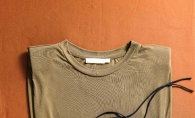I fought many battles with my mom while shopping for back-to-school clothes as a kid. She insisted I try on the clothes in the fitting room before she would fish out her checkbook; I had an aversion to those brightly lit stalls, and avoided them even at the expense of her irritation. In a comical turn of events, I now try on clothes for a living. I am a fit model; this is my story.
Every Tuesday and Thursday, I spend part of my afternoon modeling samples of next season’s fashions for a women’s clothing company at their corporate headquarters in Plymouth. I work primarily with the technical designers of Christopher and Banks in Plymouth. Once the designers see the samples on my figure, they are able to make final changes before the items are approved for production. Oftentimes, the designers call for minor adjustments: shorten the sleeves a quarter inch, nip in the waist a bit, widen across the back. On rare occasions, I emerge from the dressing room in an item that prompts the designer to laugh, shake her head and wave me closer. Gritting safety pins between her teeth, she works her magic, cutting, folding and pinning away.
I’m a size 8 petite for the company, though I’m usually a size 6 in everything else (insert emoticon here). There are only three fit models, including me: one each for Missy, petites and women (plus-size). I’m not sure how they come about their measurements, that is, why they need their petite model to be a size 8 (I believe Missy is a size 10 or 12).
Every product category (bottoms, knit tops, sweaters) has a designer in charge of assuring technical details—such as pocket placement, sleeve length and overall garment proportions—conform to company standards. The designers pay special attention to how well the garment fits on a fit model. When the designers receive samples of their product category from manufacturers, the samples are measured, then placed in the Fit Room for me to try on. The designer compares her measurements to the original specifications and assesses how the numbers look on me. I’m asked how the garment feels, whether I notice any pulling or digging. Usually, the designer’s practiced eye zeroes in on problem areas before I can even identify them. When a garment fits just right, there are smiles all around. With nothing left to do, the designer throws up her hands and exclaims, “Approved!”
Sometimes, an item will reappear on the Fit Room clothing rack, prompting more adjustments. Bottoms and jackets tend to be repeat offenders, as these items are tricky to get right. (No surprise here: These items are notoriously difficult for women to shop for.)
When I started work as a fit model in March 2013, I was looking to supplement my income as a freelance writer. I wound up with the best job I’ve ever had. For three short hours a week, I glimpse the inner workings of an industry I wouldn’t otherwise know. But it’s the people who make the job fun: I interact with several designers, buyers and managers, and each person brings a unique personality to the table.
Though I still prefer the dentist’s chair to a department store fitting room (this isn’t as severe as it might sound; I don’t mind the dentist), I also prefer clothes that fit right to ones that don’t. Thanks to my experience as a fit model, my definition of clothes that fit right has narrowed. Where I could once forgive a jacket’s too-narrow shoulders, a pant that collapses in the rear or a sweater hem that creeps upward, I now return those items to the rack. While it’s easier in the short-term to buy an item solely based on how it looks on a hanger or a website, taking the trouble to ensure fit will save time, money and effort.
I may have won most of the battles I fought against my mom as a kid, but I’ve since surrendered the war.
4190 Vinewood Lane N., 763.268.0731; christopherandbanks.com.









